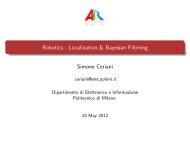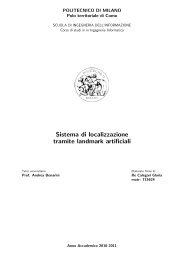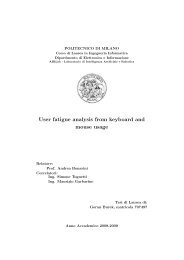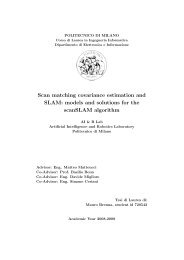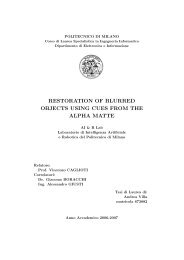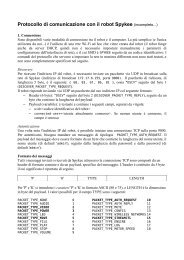Submitted version of the thesis - Airlab, the Artificial Intelligence ...
Submitted version of the thesis - Airlab, the Artificial Intelligence ...
Submitted version of the thesis - Airlab, the Artificial Intelligence ...
Create successful ePaper yourself
Turn your PDF publications into a flip-book with our unique Google optimized e-Paper software.
48 Chapter 4. Control<br />
distance to <strong>the</strong> target position. Each distance is divided by a constant, <strong>the</strong>n<br />
multiplied with <strong>the</strong> multiplier defined as FAST, NORMAL and CLOSE.<br />
Then ano<strong>the</strong>r constant which is <strong>the</strong> minimum value that can initiate <strong>the</strong><br />
motors movement is added. Hence, <strong>the</strong> mapping that each value set by <strong>the</strong><br />
PWM signal generates a motion, is achieved. The multipliers are defined<br />
according to <strong>the</strong> distance <strong>of</strong> <strong>the</strong> robot to <strong>the</strong> target object. For <strong>the</strong> distances<br />
between 1200 mm and greater, <strong>the</strong> corresponding multiplier is classified as<br />
FAST, between 1200 mm and 750 mm <strong>the</strong> multiplier is NORMAL, and for<br />
<strong>the</strong> distances between 750 mm and 300 mm it is CLOSE. By defining such<br />
control mechanism as FAST, NORMAL, CLOSE we are able to create three<br />
different speed limits for <strong>the</strong> motors, which are all mapped from 60% to 85%<br />
<strong>of</strong> <strong>the</strong> duty cycle where <strong>the</strong> motion is visible. As an example case, when<br />
<strong>the</strong> robot detects a target at 3 meters, <strong>the</strong> motor speeds will be set with<br />
multiplier FAST until <strong>the</strong> distance to <strong>the</strong> target reaches 1.2 meters. When<br />
reached to 1.2 meters, <strong>the</strong> motor speed will be set with multiplier NORMAL<br />
until <strong>the</strong> detected target distance is less than 700 millimeters. And finally,<br />
<strong>the</strong> motors speeds will be set with multiplier CLOSE from 700 mm until <strong>the</strong><br />
target is reached. This mechanism allows to achieve more precision in <strong>the</strong><br />
motion, since <strong>the</strong> mapping guarantees that each motor speed set by PWM<br />
will generate areasonablemotion. Moreover, instead<strong>of</strong> tryingtomapall <strong>the</strong><br />
speeds uniquely, indeed we are trying to map only one third <strong>of</strong> <strong>the</strong> speeds,<br />
from <strong>the</strong> predefined speed ranges to 60%-85% <strong>of</strong> <strong>the</strong> PWM value in <strong>the</strong> duty<br />
cycle. Even though <strong>the</strong> robot goes to target with an unexpected path, <strong>the</strong><br />
path is corrected as <strong>the</strong> robot comes closer since <strong>the</strong> slow motor speeds are<br />
more precise and easy to achieve.<br />
Even though <strong>the</strong> solution is not working perfectly, <strong>the</strong> robot is able to<br />
go to <strong>the</strong> target successfully almost every time. The travel time and number<br />
<strong>of</strong> movements in order to reach <strong>the</strong> target are not optimal, but this result<br />
should be regarded as normal since we are not using any encoder to detect<br />
<strong>the</strong> movement in <strong>the</strong> motors.<br />
The need for an optimization <strong>of</strong> <strong>the</strong> PWM signal is also related to <strong>the</strong><br />
result <strong>of</strong> <strong>the</strong> miscalculation <strong>of</strong> <strong>the</strong> required torque. We selected motors that<br />
do not have enough torque power for our robot. This brought <strong>the</strong> problem<br />
<strong>of</strong> <strong>the</strong> arrangement <strong>of</strong> <strong>the</strong> PWM signal in order to run <strong>the</strong> motors. Since<br />
<strong>the</strong> motors have less torque than we expected, almost 50% <strong>of</strong> <strong>the</strong> PWM is<br />
wasted. First trials to optimize this inefficiency have been made by changing<br />
<strong>the</strong> frequency <strong>of</strong> <strong>the</strong> PWM to a higher or a lower frequency, but <strong>the</strong>se<br />
trials did not give good results. Later, we found <strong>the</strong> proper configuration,




